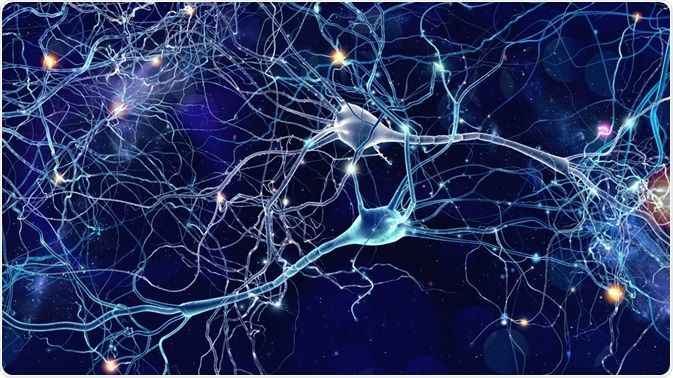Neurobiology is a division of science that is regarded as a subdiscipline of both neurology and biology. This field of science deals with the study of cells of the nervous system and their role in the regulation of human behavior and processing of various information.

Neurobiology. Image Credit: whitehoune/Shutterstock.com
Improper functioning of the nervous system leads to various neurobiological diseases such as Alzheimer’s, Huntington’s, Parkinson’s, autism, cerebral palsy depression, obsessive/compulsive disorders, and many others. Neurobiological diseases are caused by various reasons or combinations of various factors such as genetic, environmental, and metabolic factors.
At the tissue level, neurobiology consists of neurons, glial cells, and the extracellular matrix. Each component has prominent roles. Neurons or nerve cells are involved in processing information, whereas, the glial cells provide structural support, protection, and nourishment to the neurons. At the molecular level, the brain’s extracellular matrix provides support for both neurons and glial cells.
Many neurobiological disorders occur due to fluctuations in the level of neurotransmitters, whose primary functions are activating, inhibiting, or controlling neurons. These disorders may also be caused owing to damaged neurons, and hypo- or hyper-production of neurotransmitters.
How are the Different Regions of the Brain Linked to Behavior?
Each region of the brain is related to different behavior and neurobiology. Researchers aim to understand the specific connection between the two, i.e., the parts of the brain and behavior. Scientists have been successful in identifying the role of the frontal lobe of the brain. This region of the brain is connected to judgment, abstract thought, personality, problem-solving, emotions, planning, and attention.
Another important function of the frontal lobe (Broca area) is speech. The parietal lobe is associated with the understanding or interpretation of language, spatial perception, and visual signals. The occipital lobe is also involved in interpretation, i.e., visual cortices. The temporal lobe is associated with understanding language and hearing.
Scientists have devised many tools such as electroencephalography (EEG) to study the patterns of neuronal activity. EEG is regarded as an important clinical tool that helps understand the relationship between behavior and brain functions.
Types of Neurobiology Research
For many years, scientists have been conducting extensive research in various sub-fields of neurobiology. Some of these are discussed below.
Molecular Neurobiology
Molecular neurobiology deals with the submicroscopic details of the axon terminal and also focuses on the understanding of the complex mechanisms of synaptic transmission. There are two kinds of synaptic transmission, i.e., rapid and slow.
Rapid transmission is associated with transmitter-gated ion channels. It has many important functions such as the production of neurotransmitters. The slow transmission is related to membrane-spanning proteins linked to guanine-nucleotide-binding proteins.
Neurobiology of Addiction
Addiction to alcohol and substances results in various health hazards and economic burdens on individuals and families. In the past decade, researchers have made several breakthroughs in the field of neurobiology of addiction. The neural circuits play a vital role in addiction.
Two of the most important aspects of the neurobiology of addiction research are the understanding of the neurocircuitry of addiction and the molecular biology of addiction targets. The identification of transduction and transcription factors that are associated with the maintenance and development of addiction may help prevent relapse and safeguarding an addict. Human brain imaging studies also play a key role in understanding changes in the regions of brain activity with various addictions.
Neurobiology of Aging
This is one of the most studied areas where the researchers study how normal brain aging takes place. Researchers study the relationship between aging and neurodegenerative processes, cognitive decline, memory impairment, the decline of estrogen levels in older females, etc.
Generally, non-human primates are used to study cognitive changes related to aging and age-related diseases. The advantages of using non-human primates (e.g., monkeys) as a research model include similarity with human beings in terms of their ability to conduct tasks and physiological and biochemical changes related to aging.
Neurobiology of Anxiety
Researchers investigate the changes in neuron, neuroendocrine, and neurotransmitter activity in anxiety and depression. The emergence of anxiety disorders is predominantly found during childhood and adolescence which is also a dynamic developmental period when changes in frontolimbic circuitry occur. The frontolimbic circuitry plays a vital role in fear learning.
Researchers are interested to understand the factors governing neurobiological correlates of anxiety disorders across frontolimbic circuitry development. The anterior cingulate cortex, amygdala, prefrontal cortex, and hippocampus contribute to fear conditioning. Scientists have reported an altered volume and high level of activation amygdala in children and adolescents with anxiety disorders.
Neurobiology of Autism
Autism Spectrum Disorder (ASD) is a neurodevelopmental disorder. Some of the common ASD attributes are lack of social cognition, communication, and behavioral flexibility. Researchers explained that several factors are responsible for the onset of ASD such as disruption in the early development of the brain at a molecular and cellular level, oxidative stress, an unbalanced ratio between specific neuronal populations, and maturation/differentiation process, etc.
For a better understanding of the disease, researchers use a novel technique that involves the in vivo development of brain organoids, which are derived from the patient’s induced pluripotent stem cells. Researchers believe that organoids are an excellent modeling system for elucidating the role of environmental and epigenetic factors for ASD.

Autism. Image Credit: SewCream/Shutterstock.com
Neurobiology of Social Attachments
The neurobiology of social attachment entails the neural systems associated with reproduction, social engagement behaviors, and homeostasis. Various neuropeptides such as oxytocin, vasopressin, etc., play a key role in forming social bonds. Researchers have reported that these effects vary across species and gender. Dopamine also affects the formation of social bonds.
There are many more different types of neurobiology, such as neurobiology of sleep, bipolar disorder, consciousness suicide, trauma, social attachment, language, etc. The understanding of different types of neurobiology at the molecular and genetic level would provide treatment to various prevailing diseases.
Sources
- Sheldrick-Michel, T.M. et al. (2017). Neurobiology of autism spectrum disorders, European Psychiatry, 41, pp. 45-46.
- Lieberwirth, C. and Wang, Z. (2014). Social bonding: regulation by neuropeptides Frontiers in Neuroscience. 8, pp 171.
- Qiu, H. et al. (2011). Cardiovascular Effects of Aging in Primates—Gender Differences, Editor(s): Edward J. Masoro, Steven N. Austad, In Handbooks of Aging, Handbook of the Biology of Aging (Seventh Edition), Academic Press, pp. 385-404.
- Angevine, B.J. (2002). Nervous System, Organization of, Editor(s): V.S. Ramachandran, Encyclopedia of the Human Brain, Academic Press, pp. 313-371.
- Koob, G. F., and Simon, E. J. (2009). The Neurobiology of Addiction: Where We Have Been and Where We Are Going. Journal of drug issues, 39(1), 115–132.
Further Reading
Last Updated: Feb 25, 2021